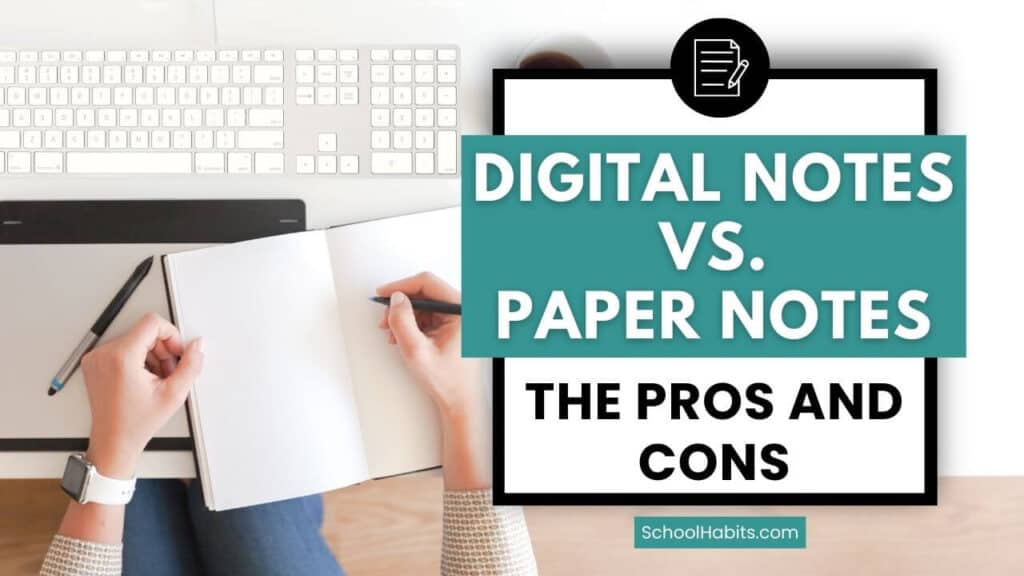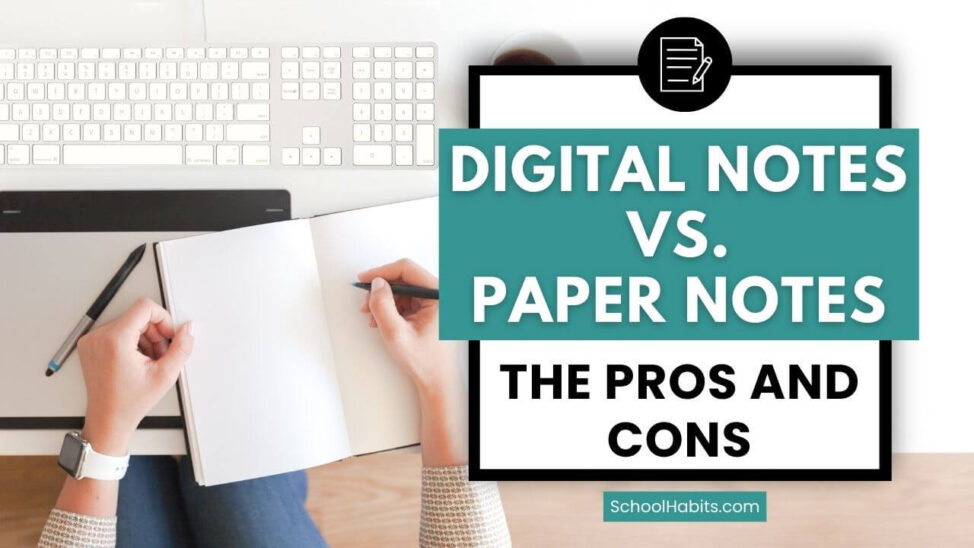
By Katie Azevedo, M.Ed.
If you regularly take notes in class, you’re far ahead of students who don’t take notes in class. Even if you’re taking notes on a napkin, that puts you light years ahead of students who don’t take notes at all.
So, assuming you already understand the benefits of taking notes in the first place, I’ll bet your next question is about digital notes vs. paper notes.
In this blog post, I’m breaking down the debate between digital notes and paper notes, so that you can make an informed decision about which method will be best for you.
However, in full transparency, I almost always recommend hand-written notes over typed notes. Even though the ultimate choice is up to you, it’s important to understand that taking notes by hand increases comprehension and retention more so than typing your notes.
I’m not against digital notes entirely, especially in situations where a student might be unable to take notes, but the pros of taking notes by hand far outweigh the pros of taking notes digitally.
To prove that I’m not totally against digital notes, I’ve made this tutorial about how to take digital notes.
Another important distinction we need to make before we get into the rest of the post is in the definition of digital notes: Digital notes could be considered typing notes in a Google or Word Doc, or hand-writing notes with an Apple Pencil or stylus in a notes app like Notability.
To be clear, as long as there is no extenuating situation involving fine motor deficits or significant handwriting impediments, hand-writing notes — whether on paper or with a stylus — is nearly always more effective for comprehension and retention than typing notes on a keyboard. I explain the reasoning for this below.
Digital Notes vs. Paper Notes
As you consider the pros and cons of digital and paper notes, I need you to keep this important fact in mind: The entire point of taking notes is to increase your understanding of something you’re learning, as well as to create a resource that you can use to further study the material in the future. Do you know these 3 note-taking secrets of straight-A students?
When determining which notetaking method is right for you, how effective a strategy is in helping you learn the material far outweighs how convenient the strategy is.
Pros and Cons of Taking Digital Notes
There are pros and cons to taking digital notes. Let’s look at some of them, below.
PROS of Digital Notes
Let’s take a look at four benefits of taking digital notes.
Access Them Everywhere
An obvious benefit of taking digital notes is that you can access them everywhere. You don’t need to remember which notebook to bring with you to class, and you can even access them on your phone. (Bad idea, but it’s an option if you’re in a pickle.)
Unlimited Storage
Obviously, with digital notes, you never run out of space to store your notes.
Neat and Easy to Revise
Digital notes are neater than paper notes, even for people with the neatest handwriting. Digital notes are also easy to revise, as you can add or delete information without making a mess.
Easy to Insert Images and Diagrams
If you’re taking digital notes, it’s super simple to insert relevant images and diagrams. If you’re taking notes from a textbook, you can take a picture and insert the image into your notes. Or, if you’re taking notes from a digital source, you can take and insert a screenshot.
CONS of Digital Notes
Now, let’s look at five cons of taking digital notes.
Faster (This Isn’t Necessarily a Good Thing!)
Taking digital notes can be faster for some people. While this may seem like a benefit, that’s not necessarily the case. When we take notes too quickly, it can decrease the learning process (what?!) because we are not fully processing what we’re writing down. In other words, we’re writing down words quickly but not understanding what we’re writing. This defeats the entire point of notes.
When you write notes by hand, you don’t have time to write down everything, which forces you to distill information into only the most essential. To do this, you need to think about the material — and this increases your comprehension.
Can’t Flip Through Them
Don’t underestimate this particular disadvantage of digital notes. When our notes are in a Google or Word document, we miss out on the cool thing our brains do, which is remember where things are spatially located on a page.
When you take notes on paper, your brain is better able to recall information based on its placement on a page. You may be familiar with this scenario if you’ve ever flipped through your paper notes, looking for something specific that you remember being in the top right corner, for example.
Leads to Too Many Notes
This con is related to the first con in this list, which is that typing digital notes is faster than writing notes by hand. When we take notes faster, we can take more notes, which is not always good.
Our notes are supposed to be a collection of the most important material. They are not supposed to contain everything our teacher says or everything from the textbook. If your notes of full of too much information, you can’t focus on the right material to study. (PS: If your notes are disorganized, you need these note-organization tips.)
Miss out on Kinesthetic Connections to Memory
Multiple studies have shown memory and learning advantages when students hand-write their notes vs. type them.
The authors of a 2023 study reported in a 2024 edition of Frontiers in Psychology, report that their results reveal “whenever handwriting movements are included as a learning strategy, more of the brain gets stimulated, resulting in the formation of more complex neural network connectivity.” They also conclude that “It appears that the movements related to typewriting do not activate these connectivity networks the same way that handwriting does.”1
In plain language, we engage more of the brain when we write notes by hand than we do when we type. When it comes to learning, we want to engage as much of the brain as possible.
Limited Functionality and Design
Taking notes should be a creative process as much as it’s an “intellectual” process. Your notes should be filled with arrows, sidenotes and connections you make between concepts. Or perhaps you like to draw out visuals and graphic representations of ideas. When you type your notes, you lose the option to add these creative elements. This is not good, as additions like arrows and graphics can improve your comprehension and memory of the material.
Pros and Cons of Taking Paper Notes
There are pros and cons to taking paper notes. Let’s look at some of them, below.
PROS of Paper Notes
Let’s take a look at four benefits of taking paper notes.
Better Comprehension
Taking notes by hand increases your comprehension of what you’re writing. I’ve already explained the science behind this fact in the sections above, but here are the two primary reasons for this:
- Taking notes by hand slows down the note-taking process, which forces you to distill the concepts into only the essentials. In order to do this, you must understand what you’re writing.
- Taking notes by hand activates more parts of the brain related to learning than does typing notes. (Again, here’s just one of many studies that prove this.)
Benefit from Spatial Memory of Where Information is on the Page
Taking notes on paper creates notes that are easy to flip through. I have explained this in the “con” section above, but the gist is that when we take notes on paper, our brain is better able to recall information based on its placement on a page. Our neat little brains are really good at spatial memory!.
Allows for Creativity and Connections
Taking paper notes allows you to add creative elements to your notes, which in turn can increase your comprehension. When we take notes on paper, we can add arrows, sidebars, and other icons or visuals that enhance our understanding of what we’re writing down. You can’t do this if you type your notes.
Improves the Quality of Your Notes
I’ve said this a few times already, but writing your notes by hand slows down the note-taking process. This is a good thing because it forces us to think about what we’re writing before we write it.
When the clock is ticking and your teacher is moving quickly, you only have time to write down the most essential content, which means that your notes will contain higher-quality information. In other words, it will have only the good stuff.
CONS of Paper Notes
If you are able-bodied, there are not many cons to paper notes. Below are two.
Limited Access
When you take notes on paper, you can obviously only access those notes on the paper. If you forget to bring your notebook to class or to your study session across campus, you’re out of luck. (Solution: Don’t forget your notebook.)
Difficult for People with Physical Limitations
Taking notes on paper is not always feasible for people with fine motor deficits, physical impairments, dysgraphia or other exceptionalities. If this is you, then taking digital notes is most definitely your best option.
Final Thoughts About Digital vs. Paper Notes
At the end of the day, choosing whether to take digital or paper notes is up to you. I’ve explained the pros and cons of each method, but you also need to consider your personal preference.
With that said, I want to remind you one final time that the entire point of taking notes is to increase your understanding of what you’re learning, and to create a resource that you can use to further study the material in the future. The point of taking notes is not speed. Please keep this in mind when choosing your note-taking method.
1 Van der Weel FR and Van der Meer ALH (2024) Handwriting but not typewriting leads to widespread brain connectivity: a high-density EEG study with implications for the classroom. Front. Psychol. 14:1219945. doi: 10.3389/fpsyg.2023.1219945

